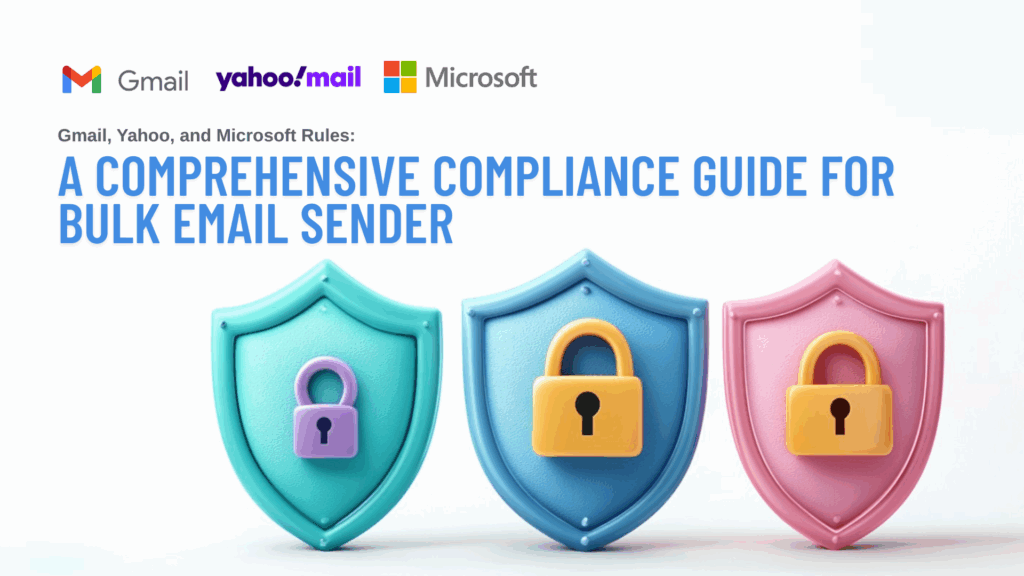
Introduction
Email deliverability refers to the ability of your emails to land in the recipient’s inbox rather than being diverted to spam or junk folders. It’s the foundation of successful email marketing because even the most well-crafted campaigns are ineffective if they don’t reach the intended audience.
Why Email Deliverability Drives High ROI
According to Litmus, email marketing can yield an impressive ROI of up to 36:1, meaning every $1 spent can generate $36 in returns, with retail and e-commerce campaigns potentially reaching 45:1. However, poor email deliverability can render your efforts futile, wasting time and resources. High email deliverability not only boosts email engagement metrics like open and click-through rates but also strengthens brand trust and customer loyalty.
What Is Email Deliverability and Why It Matters
Low email deliverability can severely impact your marketing campaigns. If emails are frequently marked as spam, your sender reputation suffers, making it harder for future emails to reach inboxes and potentially trapping you in a downward spiral. This reduces email engagement, damages brand perception, and leads to missed revenue opportunities. Prioritizing email deliverability with the best email sending practices is essential for every email marketer aiming to maximize campaign success.
Key Factors Affecting Email Deliverability
Understanding the core factors that influence email deliverability is crucial for crafting effective email marketing strategies. Below are the four key elements to focus on:
Sender Reputation
Your sender reputation is a score used by Email Service Providers (e.g., Gmail, Yahoo) to determine your trustworthiness as a sender. It’s based on metrics like open rates, click-through rates, spam complaint rates, sending frequency, bounce rates, content reliability, and user interaction. A damaged sender reputation increases the likelihood of emails being filtered into spam folders. To maintain a strong reputation, regularly clean your contact list and focus on boosting email engagement.
Email Authentication
Email authentication protocols like SPF, DKIM, and DMARC are critical for verifying the legitimacy of your emails. SPF validates your sending domain, DKIM adds a digital signature to your emails, and DMARC protects against phishing attacks. Properly aligning these email authentication protocols for better deliverability builds trust with email providers, ensuring your emails are recognized as legitimate and improving inbox placement.
Content Quality
The quality of your email content directly impacts email inbox placement. High-quality content should be clear, relevant to the recipient’s persona and interests, and personalized to drive email engagement. Conversely, using excessive promotional phrases (e.g., “free” or “buy now”) or inappropriate subject lines (e.g., all caps or excessive emojis) can trigger spam filters. Avoiding these pitfalls is key to how to avoid spam filters in email marketing.
List Hygiene
List hygiene involves regularly cleaning your contact list to remove invalid or inactive email addresses. High bounce rates, whether hard bounces (invalid addresses) or soft bounces (temporary issues), can harm your sender reputation and signal to email providers that your list may contain spam traps, indicating non-compliant list-building practices. Maintaining a clean list demonstrates respect for your subscribers and boosts email deliverability while reducing spam complaints.
8 Proven Practices to Improve Email Deliverability

Here are seven actionable strategies to enhance email deliverability in 2025, complete with practical examples and tools to help you succeed.
1. Use Double Opt-In
Beyond GDPR requirements for retaining proof of consent, implementing double opt-in ensures subscribers confirm their subscription (e.g., via a confirmation link). This verifies email addresses and ensures recipients are genuinely interested, reducing spam complaints and boosting email engagement. For example, tools like Mailchimp automate this process.
2. Set Up SPF, DKIM, and DMARC Correctly
Even when using an Email Service Provider (ESP), ensure email authentication protocols (SPF, DKIM, DMARC) are properly configured and aligned. Use a one SPF record, one DMARC policy, and multiple DKIM records if you work with multiple ESPs to maintain email authentication protocols for better deliverability.
3. Regularly Clean Your Contact List
Remove inactive or invalid contacts to minimize bounce rates and improve overall campaign email engagement. For high-volume senders, clean your list every 3-6 months, sunset or segment contacts with no opens for over a year, or those causing hard bounces.
4. Personalize Email Content and A/B test
Tailor content based on recipient data or user personas to capture attention and improve open rates. For example, a subject line like “[Name], Your Exclusive Offer Awaits!” is more engaging than generic content, enhancing email inbox placement. Remember to run A/B tests with only one variable at a time to discover your audience’s preferences. This also helps you avoid triggering ISP spam filters or tabs.
5. Warm Up New IP Addresses
When using a new sending IP and domains, start with a small volume (e.g., 100 emails on day one) and double the volume daily to build sender reputation with mailbox providers. This ensures better inbox placement over time.
6. Optimize Subject Lines
Avoid trigger words like “free,” “90% off,” or “you’ve won” that make your emails appear suspicious. Keep subject lines concise and compelling, such as “Discover This Week’s Marketing Tips!” instead of “Free Marketing Course!” to master how to avoid spam filters in email marketing.
7. Include a One-Click Unsubscribe Option
As required by Gmail for bulk senders, provide a clear, intuitive one-click unsubscribe link or button to respect your subscribers’ preferences. This practice fosters trust and aligns with the best email sending practices for inbox placement.
8. Monitor Key Metrics
Use your ESP’s analytics or pixel tracking to monitor open rates, click-through rates, bounce rates, and spam complaints. These email deliverability metrics to track for better inbox placement help identify issues early and optimize performance.
How to Measure Email Deliverability Success
To evaluate your email deliverability performance, track these key metrics and their benchmarks:
- Inbox Placement Rate (IPR): Measures the percentage of emails reaching the inbox. Aim for 85% or higher, with 95-98% being an optimal range.
- Bounce Rate: Keep hard bounces below 2% and resolve soft bounces promptly.
- Open Rate: Indicates recipient interest, with an industry average of 15-25%. Due to increasing bot activity from email providers, aim for stable rather than fluctuating open rates.
- Click-Through Rate (CTR): Measures content engagement, targeting 1-5%. Like open rates, focus on stable values.
- Spam Complaint Rate: Keep below 0.1%, as required by Gmail and Yahoo for bulk senders, to protect your sender reputation.
Monitoring Steps:
- Use your ESP’s built-in analytics (e.g., HubSpot, Mailchimp) to track email deliverability metrics to track for better inbox placement.
- Leverage Google Postmaster Tools to monitor Gmail performance.
- If metrics show anomalies (e.g., high bounce rates), review email authentication settings, sending volume, content quality, or list hygiene and adjust promptly.
Next Steps
Improving email deliverability is critical to email marketing success. By optimizing your sender reputation, implementing robust email authentication protocols for better deliverability, enhancing content quality, and maintaining list hygiene, you can significantly increase inbox placement. Start auditing your email marketing strategy today—verify SPF, DKIM, and DMARC settings, and explore free tools like Google Postmaster Tools to monitor performance.
Take action and work with me to ensure your 2025 campaigns soar with the best email sending practices!
Ready to start?

